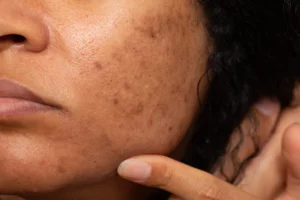Table of Contents

The quest for radiant and flawless skin often encounters a common obstacle – the presence of skin dark spots. These pigmented areas, distinguished by their varying sizes and appearances, pose a concern for many individuals.
Yet, amidst this desire for skin that glows, there exists a common concern – the appearance of dark patches. These patches often disrupt our skin’s natural harmony, causing unease and raising questions about their origin.
Understanding the reasons behind these dark patches is crucial. By unraveling the root causes, we can not only address the issue at its core but also embark on a journey towards healthier, clearer skin. In this article, we will delve into the various aspects of dark patches, their causes, and the importance of gaining this knowledge.
Dark patches refer to areas of the skin that appear darker than the surrounding skin tone. These patches can vary in size, shape, and color, often standing out prominently and raising concerns.
Commonly Affected Areas
Dark patches can emerge on different parts of the body, such as the face, neck, hands, and arms. These areas are particularly susceptible to the uneven distribution of pigmentation.
Different Types of Dark Patches
- Hyperpigmentation: This occurs when certain areas of the skin produce more melanin than usual, leading to darkened patches.
- Melasma: Often triggered by hormonal changes, melasma results in grayish-brown patches, typically on the face.
- Age Spots: Also known as liver spots, age spots are caused by prolonged sun exposure and appear as small, dark areas on the skin.
- Post-Inflammatory Hyperpigmentation: Following skin inflammation or injury, these patches arise as a result of increased melanin production.
Factors Behind Dark Patches
- Sun Exposure: Overexposure to the sun’s UV rays can stimulate excess melanin production, leading to the formation of dark patches.
- Hormonal Changes: Fluctuations in hormones, such as during pregnancy or menopause, can contribute to the development of dark patches.
- Skin Injuries or Trauma: Scars and wounds, including those from acne, can trigger the skin to darken in response to the healing process.
- Genetics: Genetic predisposition can play a role in how our skin responds to various factors, including pigmentation.
- Medical Conditions: Certain medical conditions, like Addison’s disease or insulin resistance, can influence skin pigmentation and contribute to the appearance of dark patches.
Sun’s Impact on Skin Pigmentation
- UV Rays and Melanin Production: The sun emits ultraviolet (UV) rays that stimulate the skin to produce more melanin, which can lead to the development of dark patches.
- Importance of Sun Protection: Shielding your skin from the sun’s rays through sunscreen and protective clothing is vital to prevent the triggering of excessive melanin production.
Influence of Hormonal Changes
- Pregnancy and Birth Control: Hormonal shifts during pregnancy and the use of birth control methods can contribute to the emergence of dark patches, especially melasma.
- Menopause: Hormonal fluctuations during menopause can also play a role in the development of skin discoloration.
Understanding Post-Inflammatory Hyperpigmentation
- Acne Scars and Skin Injuries: Dark patches can arise as the skin heals from injuries, such as acne scars or cuts, due to an increased concentration of melanin in the affected areas.
- Inflammation and Pigmentation: Skin inflammation triggers the release of chemicals that can lead to an uneven distribution of pigmentation, resulting in darker spots.
ALSO READ:
Skin Grafts Unveiled: A Comprehensive Guide
Top 10 Skin-Toning Creams for Chocolate Skin
Seven Tips to Maintain Healthy Skin
Healing Pink Skin After a Burn: A 9-Step Guide for Recovery
Leave a Reply